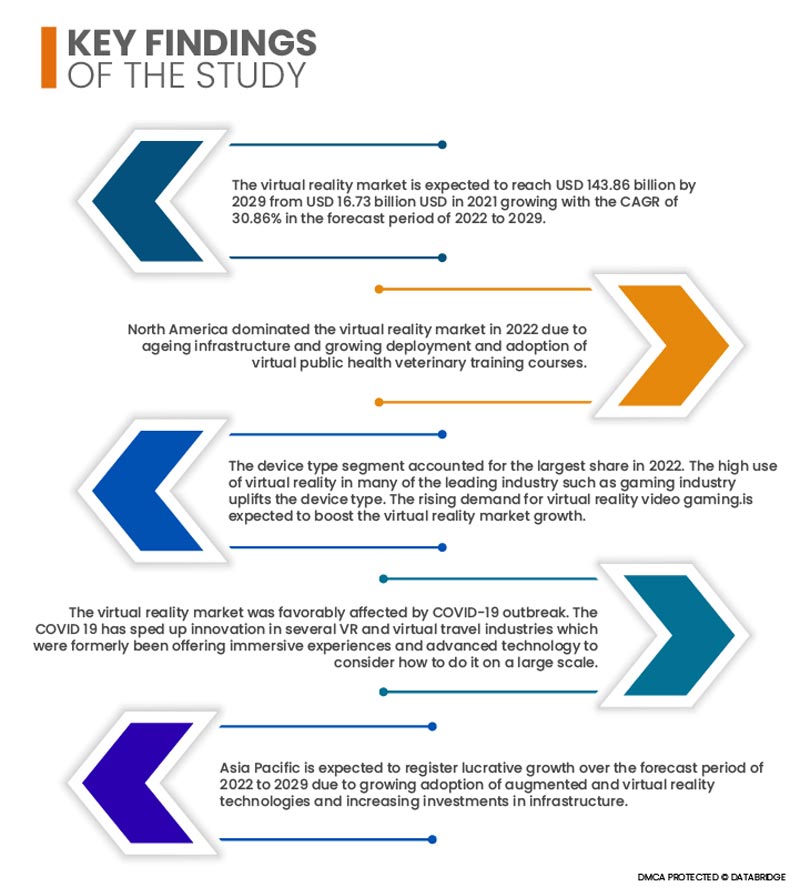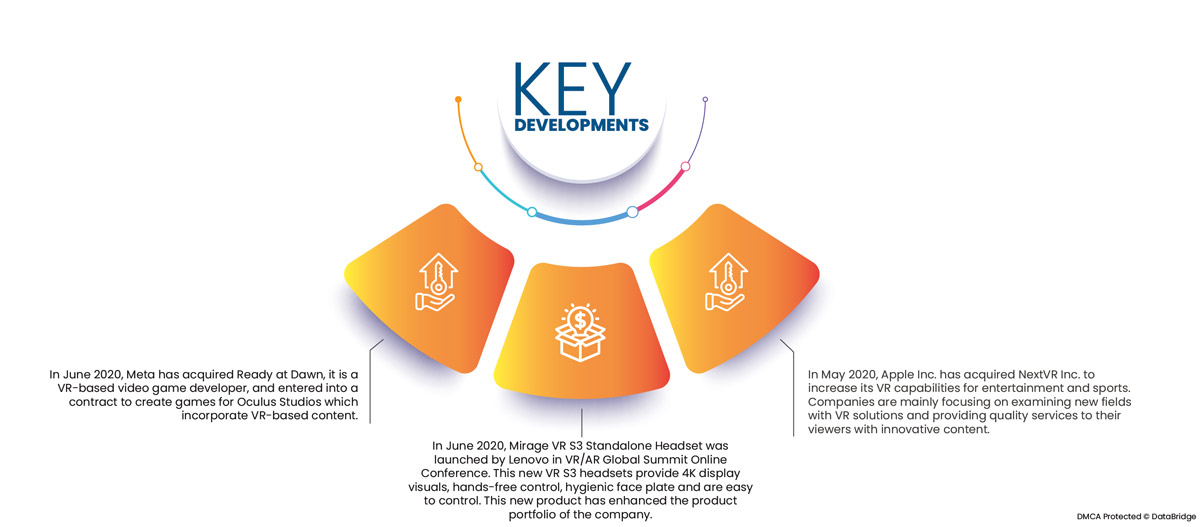The fastest growing trend of virtual shopping is creating business opportunities for firms in the virtual reality industries. Consumers can easily shop for things and see how they look in their homes using virtual reality technology. The increase in internet connectivity and the growth of the mobile gaming industry are expected to boost the growth of the global virtual reality market.
Access full Report @ https://www.databridgemarketresearch.com/reports/global-virtual-reality-market
Data Bridge Market Research analyses that the virtual reality market is expected to reach USD 143.86 billion by 2029 from USD 16.73 billion USD in 2021, growing with the CAGR of 30.86% in the forecast period of 2022 to 2029. The easy availability of affordable VR devices is projected to propel the growth of the market as the rise in number of enterprises other than gaming and other consumer entertainment subsectors are testing and adopting VR technologies in a wide range of work-related applications.

Increasing adoption of advanced technologies is expected to drive the market's growth rate
As per a national survey, 90% of instructors concur that using virtual reality technology to create differentiated and tailored student experiences is a viable strategy. The adoption of virtual reality technology are moving beyond video gaming and use in different areas such as professional training and content creation. Moreover, innovative companies are experimenting with a wave of new applications for virtual reality, which is also the major driving factor for market growth.
Report Scope and Market Segmentation
|
Report Metric
|
Details
|
|
Forecast Period
|
2022 to 2029
|
|
Base Year
|
2021
|
|
Historic Years
|
2020 (Customizable to 2014- 2019)
|
|
Quantitative Units
|
Revenue in USD Billion, Volumes in Units, Pricing in USD
|
|
Segments Covered
|
Component (Hardware and Software), Device Type (Head-Mounted Displays, Projectors and Display Walls and Gesture-Tracking Devices), Technology (Fully Immersive, Non-Immersive and Semi Immersive), Vertical (Entertainment and Media, Healthcare, Industrial, Commercial, Aerospace and Defense, Automotive, Education and Others)
|
|
Countries Covered
|
U.S., Canada and Mexico in North America, Germany, France, U.K., Netherlands, Switzerland, Belgium, Russia, Italy, Spain, Turkey, Rest of Europe in Europe, China, Japan, India, South Korea, Singapore, Malaysia, Australia, Thailand, Indonesia, Philippines, Rest of Asia-Pacific (APAC) in the Asia-Pacific (APAC), Saudi Arabia, U.A.E, South Africa, Egypt, Israel, Rest of Middle East and Africa (MEA) as a part of Middle East and Africa (MEA), Brazil, Argentina and Rest of South America as part of South America
|
|
Market Players Covered
|
Axis Communications AB (Sweden), Johnson Controls (Ireland), Sony Corporation (Japan), Avigilon Corporation (Canada), Panasonic Corporation (Japan), SAMSUNG (U.S.), Arcules, Inc. (U.S.), Google, LLC (U.S.), Microsoft (U.S.), HTC Corporation (Taiwan), Oculus (U.S.), EON Reality. (U.S.), Vuzix (U.S.), CyberGlove Systems Inc. (U.S.), Ultraleap, Inc. (U.S.), Sixense Enterprises Inc (U.S.), Lenovo (China), Autodesk Inc. (U.S.), Barco (Belgium), Psious (Spain)
|
|
Data Points Covered in the Report
|
The market report curated by the Data Bridge Market Research team includes in-depth expert analysis, import/export analysis, pricing analysis, production consumption analysis, and pestle analysis.
|
Segment Analysis:
The virtual reality market is segmented on the basis of component, device type, technology and vertical.
- On the basis of device type, the market is segmented into head-mounted displays, projectors and display walls and gesture-tracking devices.
In 2022, the head-mounted displays segment of device type segment is anticipated to dominate the virtual reality market
The head-mounted displays segment is expected to dominate the global virtual reality market with a 54.86% market share due to increasing demand for virtual reality video gaming.
- On the basis of component, the market is segmented into hardware and software. In 2022, hardware segment is expected to dominate the global virtual reality market with 60.24% market share due to the increasing adoption of VR devices across various industry verticals, such as construction, education, healthcare and retail
- On the basis of technology, the market is segmented into fully immersive, non-immersive and semi immersive. In 2022, fully immersive segment is expected to dominate the global virtual reality market with 54.89% market share because it replaces users' real-world surroundings so that they are able to fully engage with the created environment.
- On the basis of vertical, the market is segmented into entertainment and media, healthcare, industrial, commercial, aerospace and defence, automotive, education and others.
In 2022, the entertainment and media segment is projected to hold the largest share of end user segment in the virtual reality market
Entertainment and media segment is expected to dominate the global virtual reality market with 49.73% market share because it provides complete artificial environment and provide the end users a real-world environment experience
Major Players
Data Bridge Market Research recognizes the following companies as the major virtual reality market players in virtual reality market are Axis Communications AB (Sweden), Johnson Controls (Ireland), Sony Corporation (Japan), Avigilon Corporation (Canada), Panasonic Corporation (Japan), SAMSUNG (U.S.), Arcules, Inc. (U.S.), Google, LLC (U.S.), Microsoft (U.S.)

Market Development
- In June 2020, Mirage VR S3 Standalone Headset was launched by Lenovo at VR/AR Global Summit Online Conference. This new VR S3 headsets provide 4K display visuals, hands-free control, a hygienic face plate, and are easy to control. This new product has enhanced the product portfolio of the company
- In June 2020, Meta acquired Ready at Dawn, it is a VR-based video game developer, and entered into a contract to create games for Oculus Studios that incorporate VR-based content
- In May 2020, Apple Inc. acquired NextVR Inc. to increase its VR capabilities for entertainment and sports. Companies are mainly focusing on examining new fields with VR solutions and providing quality services to their viewers with innovative content
Regional Analysis
Geographically, the countries covered in the virtual reality market report are U.S., Canada and Mexico in North America, Germany, France, U.K., Netherlands, Switzerland, Belgium, Russia, Italy, Spain, Turkey, Rest of Europe in Europe, China, Japan, India, South Korea, Singapore, Malaysia, Australia, Thailand, Indonesia, Philippines, Rest of Asia-Pacific (APAC) in the Asia-Pacific (APAC), Saudi Arabia, U.A.E, South Africa, Egypt, Israel, Rest of Middle East and Africa (MEA) as a part of Middle East and Africa (MEA), Brazil, Argentina and Rest of South America as part of South America.
As per Data Bridge Market Research analysis:
North America is the dominant region in virtual reality market during the forecast period 2022 - 2029
North America dominates the global virtual reality market due to aging infrastructure and growing deployment and adoption of virtual public health veterinary training courses. Moreover, presence of major market players in this region such as Magic Leap; Apple, Inc.; Microsoft; and Google LLC is also flourishing the growth of the virtual reality market.
Asia-Pacific is estimated to be the fastest growing region in virtual reality market the forecast period 2022 - 2029
Asia-Pacific is expected to grow during the forecast period of 2022-2029 due to the growing adoption of augmented and virtual reality technologies in APAC countries. In order to encourage economic growth, many countries, such as India, China, and others, are growing their investments in infrastructure which are expected to propel the market's growth rate in this region.
COVID-19 Impact Analysis
The coronavirus pandemic has had a favorable effect on the virtual reality market. Travelers felt deprived when the epidemic barged in because the traveling was restricted. However, several VR service developers and providers have entered the market with entertaining and affordable offerings such as a new virtual reality service from Airbnb and Amazon Explore. The COVID-19 has sped up innovation in several VR and virtual travel industries that formerly offered immersive experiences and advanced technology to consider how to do it on a large scale.
For more detailed information about the virtual reality market report, click here – https://www.databridgemarketresearch.com/reports/global-virtual-reality-market










